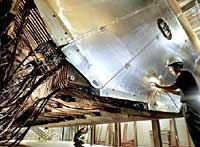Physicists Confirm Neutrinos Have Mass, Challenging Standard Model of Particle Physics
Recent findings confirm that neutrinos—a type of subatomic particle considered fundamental to the formation of the universe—do possess mass. This significant discovery comes from the Main Injector Neutrino Oscillation Search (MINOS) laboratory based in the United States.
The discovery suggests that the Standard Model, which describes the behavior and interactions of the universe’s “building blocks,” may need to be reevaluated.
Neutrinos are one of the fundamental particles that make up matter. They are often referred to as “ghostly” because they can pass through the universe, Earth’s atmosphere, and even the Earth itself with little to no interaction with ordinary matter. This property makes studying them quite challenging.
Neutrinos exist in three forms: electron, muon, and tau.
 |
First, neutrino particles are captured through a particle detector at Fermilab. (Image: BBC) |
To test their properties, scientists generated muon neutrinos at the Fermi National Accelerator Laboratory (Fermilab) in Illinois, USA. A high-energy beam of these particles was fired through a particle detector at Fermilab and then to another particle detector located 742 kilometers away in an abandoned mine in Soudan, USA.
“Because they rarely interact with matter, we can shoot them straight through the Earth, and most pass through without causing any effect,” said Dr. Lisa Falk Harris, a member of the MINOS team.
 |
As a result, the number of neutrinos detected at the Soudan facility was lower than expected. (Image: BBC) |
However, the research team confirmed that the number of neutrinos detected at the Soudan mine was less than the number sent out. Some had actually “disappeared”. “What they do is switch to a different type of neutrino,” Harris explained.
Physicists refer to the process of changing from one type of neutrino to another as flavor oscillation. To facilitate this transition, particle physics theory posits that these particles must have mass.
“The fact that we see them ‘disappear’ and perform that small transition means they must have mass,” emphasized Dr. Falk Harris.
This marks the first result from the MINOS experiment, involving scientists from 32 research institutes across six countries. It also confirms previous observations of the “disappearance” of neutrinos, first noted in 2002 by the K2K laboratory in Japan.
The evidence reinforces the notion that neutrinos having mass will significantly impact particle physics. “In particle physics, the Standard Model states that neutrinos are massless. Therefore, our findings imply that this Standard Model will need to be revisited or replaced with something else.”
In the long term, this discovery may help scientists better understand the mysterious “missing mass” in the universe.
T. An




















































